人教版英语八年级下册Unit1 Section B 1a-1d教案
- 格式:docx
- 大小:24.18 KB
- 文档页数:6
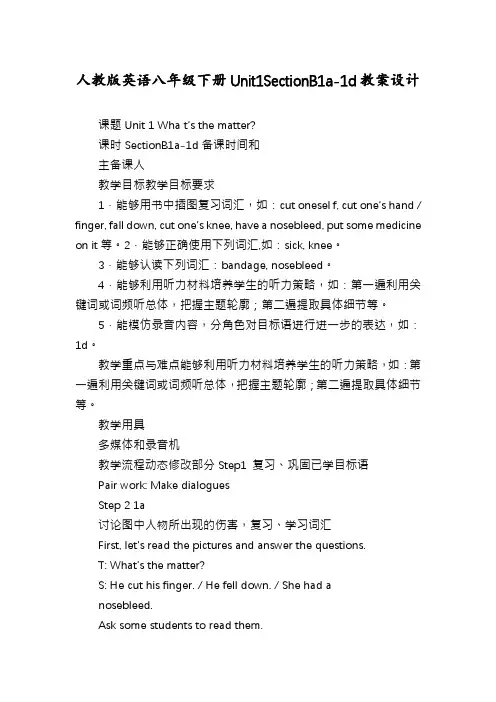
人教版英语八年级下册Unit1SectionB1a-1d教案设计课题Unit 1 Wha t’s the matter?课时SectionB1a-1d备课时间和主备课人教学目标教学目标要求1.能够用书中插图复习词汇,如:cut onesel f, cut one’s hand / finger, fall down, cut one’s knee, have a nosebleed, put some medicine on it等。
2.能够正确使用下列词汇,如:sick, knee。
3.能够认读下列词汇:bandage, nosebleed。
4.能够利用听力材料培养学生的听力策略,如:第一遍利用关键词或词频听总体,把握主题轮廓;第二遍提取具体细节等。
5.能模仿录音内容,分角色对目标语进行进一步的表达,如:1d。
教学重点与难点能够利用听力材料培养学生的听力策略,如:第一遍利用关键词或词频听总体,把握主题轮廓;第二遍提取具体细节等。
教学用具多媒体和录音机教学流程动态修改部分Step1 复习、巩固已学目标语Pair work: Make dialoguesStep 2 1a讨论图中人物所出现的伤害,复习、学习词汇First, let’s read the pictures and answer the questions.T: What’s the matter?S: He cut his finger. / He fell down. / She had anosebleed.Ask some students to read them.教学流程动态修改部分根据生活经验,判断排序,掌握目标语Please read the phrases and put them in order.按照自己生活经验,把短语进行排序。
陈述过程连续,填入顺序词来突出过程性。
Please read the sentences and add “first, next, then”. Now, let’s show youranswers.Can you write a passage according to the pictures and the sentences?Step 3 1b1.读出表格,摘录出各项中的关键词,这是正确完成本活动的重要依据Please the chart and find the key words: sick, knee, fever, nosebleed, back,head (每项中的最后一词).Let’s read them together.2.完成1b,检查反馈,确认学生正确识别目标Now le t’s listen and finish1b.Check your answers now.Step 4 1c.1.依次读出救治建议,教师注意纠正学生的读音,为听力做好准备Let’s read the advice in 1c. Pay attention to your pronunciation.(学生朗读时,纠正学生发音,必要时可采用英汉对译的办法确认他们懂得意思。
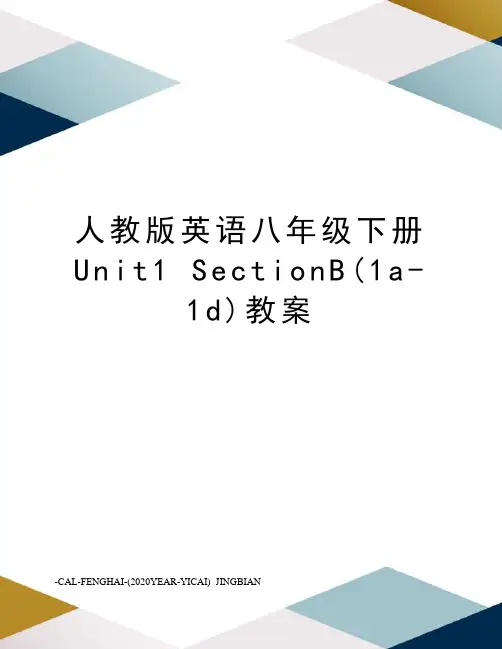
人教版英语八年级下册U n i t1S e c t i o n B(1a-1d)教案-CAL-FENGHAI-(2020YEAR-YICAI)_JINGBIANUnit1 SectionB(1a-1d)精品教案【教学目标】1.掌握本课时重点单词:knee, sick, ourselves2.掌握本课时重点短语:get hit on the head, hurt oneself, have a nosebleed3.掌握本课时重点句式: He hurt himself in P.E. class.You should run it under water.【教学环节】自主学习1.自学生词,记住拼读及拼写。
2.预习课本,找出重点短语及句子。
3.读记后完成自学导练作业。
课堂活动设计Step 1情景导入T :There are many accidents happening every day. But do you know how to deal with these problems What should you do when you have a nosebleed And what should you do when you cut yourself If you don’t know the answers to the questions,please don' worry. Today we will learn how to deal with the problems.【环节说明:由生活中经常出现的意外为话题引出本节课所要学的内容,贴近生活,引起学生的学习兴趣。
】Step 2完成教材1a的任务1. 让学生仔细观察1a中的三幅图片,然后根据图片信息回答问题:What happened to them?2. 小组讨论出现1a中的意外情况时,我们应该怎么办?然后将1a中所给出的句子按正确的顺序排序,集体核对答案。
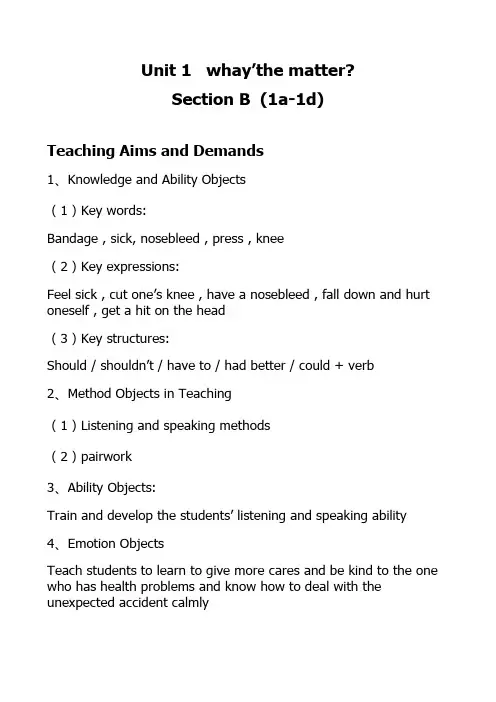
Unit 1 whay’the matter?Section B (1a-1d)Teaching Aims and Demands1、Knowledge and Ability Objects(1)Key words:Bandage , sick, nosebleed , press , knee(2)Key expressions:Feel sick , cut one’s knee , have a nosebleed , fall down and hurt oneself , get a hit on the head(3)Key structures:Should / shouldn’t / have to / had better / could + verb2、Method Objects in Teaching(1)Listening and speaking methods(2)pairwork3、Ability Objects:Train and develop the students’ listening and speaking ability4、Emotion ObjectsTeach students to learn to give more cares and be kind to the one who has health problems and know how to deal with the unexpected accident calmlyTeaching key and difficult points(1)prative conversations using the target language(2)Train and develop the students’ listening and speaking ability.Make conversation freelyTeaching Aids:CAITeaching procedures:Step 1.Greeting and RevisionGreet the class and sing the Body Song together . Show some pictures about illness.encourage students to talk about the health problems and give each of them advice.This activity reviews the health problems that students learnt last class.Step 2.new wordsShow the new words on the screen and learn the new words. Step 3.Guessing gameLet the students choose one piece of paper about an unexpected accident, then do an action, the others guess what happenedto them and give each of them advice correctly.This activity leads to the new phrases of the period.Step 4.while – task①look at the pictures of 1a . Talk about what they should do inpairs and put the actions in order.②look at 1b , talk about the problems and the treatments, give me their predictions before listening.③listen to the tape , check the problems you hear, ask some students to check the answers.④look at 1c , listen again , write the letter of each treatment to the problems.⑤Ask the students to listen and repeat.This activity provides listening pratice using the target language. Step 5.post – task.1、look at 1d.role play a conversation between the doctor andpatient. Ask the students to use the informaction in 1b and 1c to make similar conversation and practice in pairs.This activity provides guided oral ing the target language then praise them for their good work.Step 6.SummaryIn this class , we learned some new words and expressions . we also learned some unexpected accidents and how to deal with them correctly . we also listened to some tapes and we should listen after class to improve our listening skills.Step 7.Homework1.Review and recite the new words and phrases.2.Write a passage about an unexpected accident and how to deal with it calmly . we should use the sentence structures and target language to write the passage.。
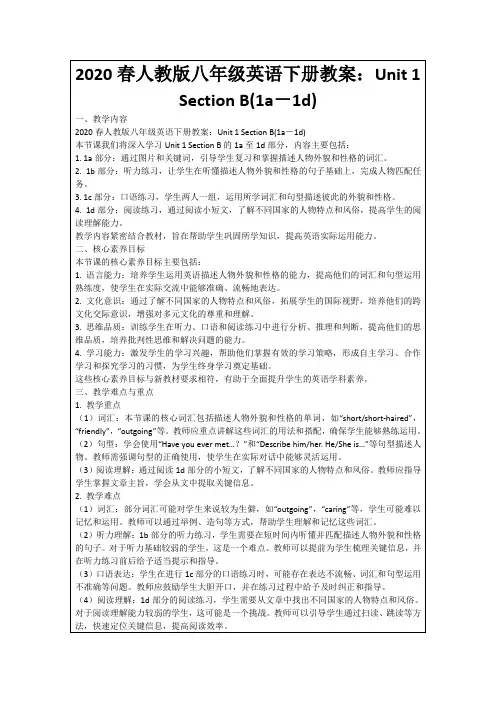
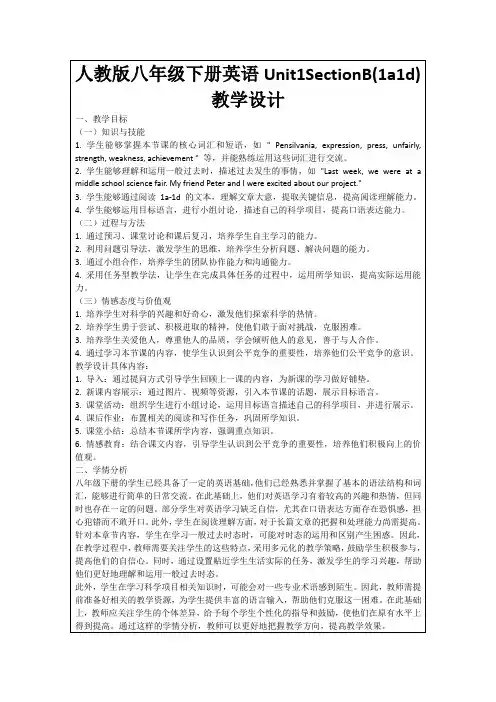
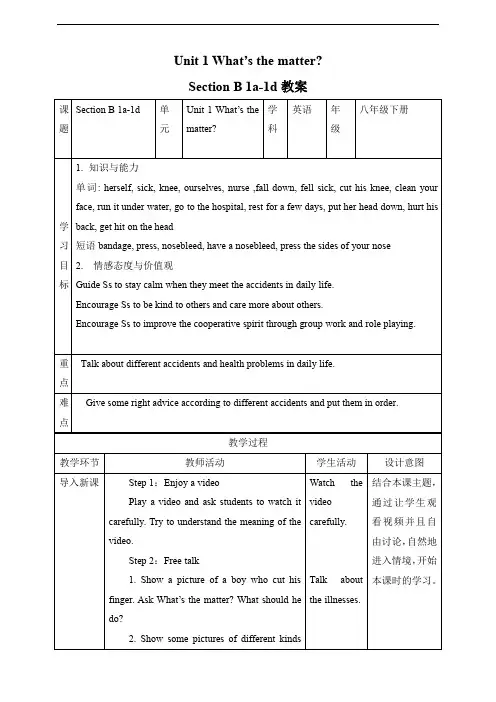
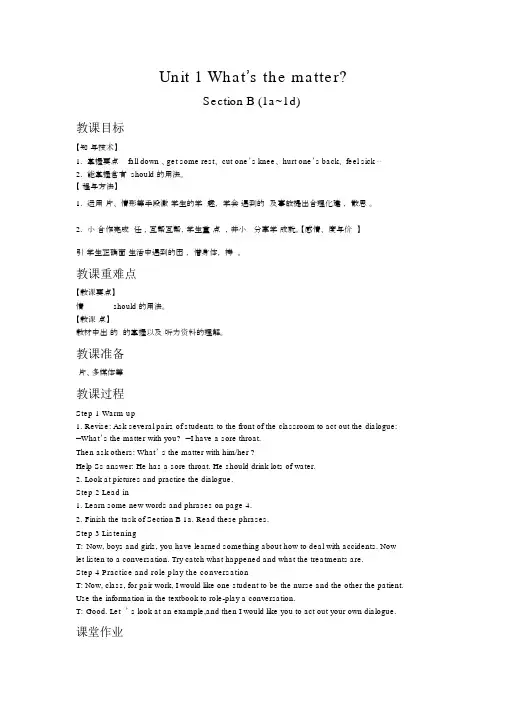
Unit 1 What’s the matter?Section B (1a~1d)教课目标【知与技术】1.掌握要点 fall down 、get some rest、 cut one’s knee、 hurt one’s back、 feel sick ⋯2.能掌握含有 should 的用法。
【程与方法】1.运用片、情形等手段激学生的学趣,学会遇到的及事故提出合理化建,散思。
2.小合作完成任,互帮互帮,学生重点,并小分享学成就。
【感情、度与价】引学生正确面生活中遇到的困,惜身体,持。
教课重难点【教课要点】情should 的用法。
【教课点】教材中出的的掌握以及听力资料的理解。
教课准备片、多媒体等教课过程Step 1 Warm up1. Revise: Ask several pairs of students to the front of the classroom to act out the dialogue:—What’s the matter with you? —I have a sore throat.Then ask others: What’ s the matter with him/her ?Help Ss answer: He has a sore throat. He should drink lots of water.2. Look at pictures and practice the dialogue.Step 2 Lead in1.Learn some new words and phrases on page 4.2.Finish the task of Section B 1a. Read these phrases.Step 3 ListeningT:Now, boys and girls, you have learned something about how to deal with accidents. Now let listen to a conversation. Try catch what happened and what the treatments are.Step 4 Practice and role play the conversationT:Now, class, for pair work, I would like one student to be the nurse and the other the patient. Use the information in the textbook to role-play a conversation.T:Good. Let ’ s look at an example,and then I would like you to act out your own dialogue. 课堂作业1.Preview the new words in Section B.2.Preview the passage of part 2b教课反思要增强对提建议句型的使用。
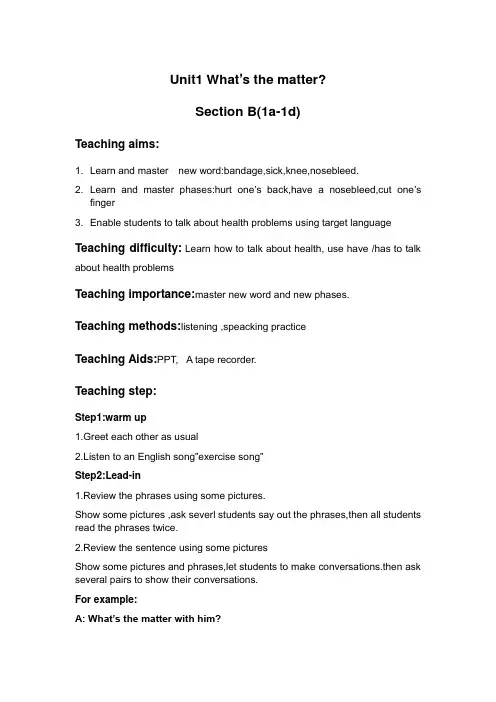
Unit1 What’s the matter?Section B(1a-1d)Teaching aims:1. Learn and master new word:bandage,sick,knee,nosebleed.2. Learn and master phases:hurt one’s back,have a nosebleed,cut one’sfinger3. Enable students to talk about health problems using target language Teaching difficulty: Learn how to talk about health, use have /has to talk about health problemsTeaching importance:master new word and new phases.Teaching methods:listening ,speacking practiceTeaching Aids:PPT, A tape recorder.Teaching step:Step1:warm up1.Greet each other as usual2.Listen to an English song”exercise song”Step2:Lead-in1.Review the phrases using some pictures.Show some pictures ,ask severl students say out the phrases,then all students read the phrases twice.2.Review the sentence using some picturesShow some pictures and phrases,let students to make conversations.then ask several pairs to show their conversations.For example:A: What’s the matter with him?B: He has a cold.A: What should he do?B: He should drink lots of hot water .Step 3:presention1. Learn new wordsLearn new words using pictures,then students read the words twice after teacher.2. Learn 1aGet Ss to work in pairs to look at the three pictures and decide together what is happening in each.Check answers as a class to ensure Ss understand the pictures.Let students make conversations in 1a,For example:A:What’s the matter?B:I cut my finger .A:What should I do?B:You should run it under water,then put some medicine on it,finally puta bandage on it .3. Do listening practice(1b,1c)Teacher explain the treatments mentioned in 1c first,then play the recording twice and ask Ss to fill in the answers for both 1b and 1c as they listen ,then check the answers. If students don’t listen clearly,teacher can play the recording again.4. Speaking practiceThe teacher may want to make it easy for Ss to do the activity and enhance their conversations .then let students make conversation using the information in 1b and 1c. finally ask several pairs to role-play their conversation.Step 4:Homework1. Review the new words and expressions.2. Write a short passage about the accidents happened in your P.E. class. Step5:SummaryToday we learned new words and phases,we did some listening practice and speaking practice.Step6:Blackboard DesignUnit 1 What’s the matter?Period 1 Section B (1a-1d) A: What’s the matter with him?B: He …A: What should he do?B: He should …New words :bandage,knee,sick,nosebleed。
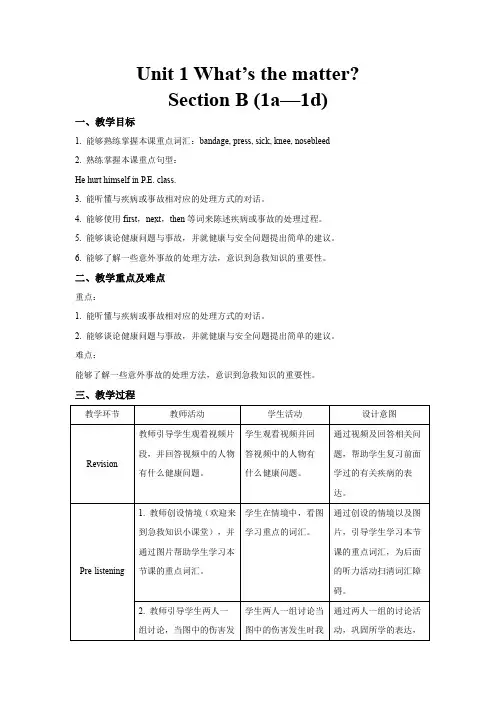
Unit 1 What’s the matter?
Section B (1a—1d)
一、教学目标
1. 能够熟练掌握本课重点词汇:bandage, press, sick, knee, nosebleed
2. 熟练掌握本课重点句型:
He hurt himself in P.E. class.
3. 能听懂与疾病或事故相对应的处理方式的对话。
4. 能够使用first,next,then等词来陈述疾病或事故的处理过程。
5. 能够谈论健康问题与事故,并就健康与安全问题提出简单的建议。
6. 能够了解一些意外事故的处理方法,意识到急救知识的重要性。
二、教学重点及难点
重点:
1. 能听懂与疾病或事故相对应的处理方式的对话。
2. 能够谈论健康问题与事故,并就健康与安全问题提出简单的建议。
难点:
能够了解一些意外事故的处理方法,意识到急救知识的重要性。
三、教学过程
四、板书设计
Unit 1 What’s the matter?
第1课时Section B (1a—1d) Key words: bandage, press, sick, knee, nosebleed
Key sentence: He hurt himself in P.E. class.。
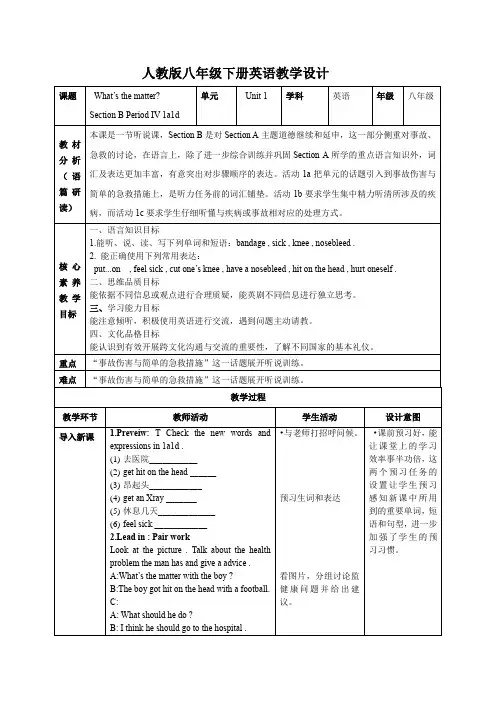
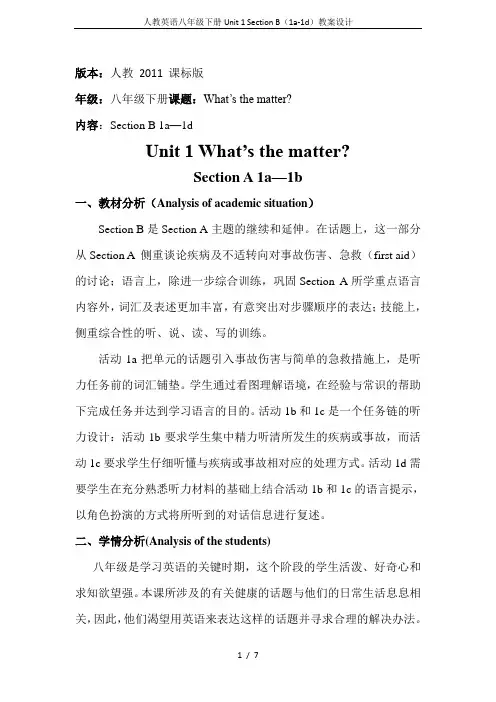
版本:人教2011 课标版年级:八年级下册课题:What’s the matter?内容:Section B 1a—1dUnit 1 What’s the matter?Section A 1a—1b一、教材分析(Analysis of academic situation)Section B是Section A主题的继续和延伸。
在话题上,这一部分从Section A 侧重谈论疾病及不适转向对事故伤害、急救(first aid)的讨论;语言上,除进一步综合训练,巩固Section A所学重点语言内容外,词汇及表述更加丰富,有意突出对步骤顺序的表达;技能上,侧重综合性的听、说、读、写的训练。
活动1a把单元的话题引入事故伤害与简单的急救措施上,是听力任务前的词汇铺垫。
学生通过看图理解语境,在经验与常识的帮助下完成任务并达到学习语言的目的。
活动1b和1c是一个任务链的听力设计:活动1b要求学生集中精力听清所发生的疾病或事故,而活动1c要求学生仔细听懂与疾病或事故相对应的处理方式。
活动1d需要学生在充分熟悉听力材料的基础上结合活动1b和1c的语言提示,以角色扮演的方式将所听到的对话信息进行复述。
二、学情分析(Analysis of the students)八年级是学习英语的关键时期,这个阶段的学生活泼、好奇心和求知欲望强。
本课所涉及的有关健康的话题与他们的日常生活息息相关,因此,他们渴望用英语来表达这样的话题并寻求合理的解决办法。
本课通过表述身体的各种不适和谈论个人健康问题,使学生学会关心自身及他人身体健康并且能提出一些建议,同时让学生了解“a healthy lifestyle”的重要性。
但是由于学生年龄和生活经验的限制,在谈论如何给合适的建议时,会遇到一定的困难。
因此,在教学过程中,利用图片、肢体语言,给予学生直观的感受,并灵活运用绷带等道具,创设真实的情境。
除此之外,教师要给予学生适时而恰当的鼓励。
Unit1 SectionB(1a-1d)教案一教学目标:[知识与技能]1.掌握重点词汇fall down、get some rest、cut one's knee、hurt one's back、feel sick...2.能掌握含有should的用法。
[过程与方法]1.运用图片、情景等手段激发学生的学习兴趣,学会对遇到的问题及事故提出合理化建议,发散思维。
2.小组合作完成细节任务,互帮互助,学生重难点词汇,并小组汇报分享学习成果。
[情感、态度与价值观]引导学生正确面对生活中遇到的困难,爱惜身体,坚持锻炼。
. 教学重难点[教学重点]情态动词should的用法。
[教学难点]教材中出现的词组的掌握以及对听力材料的理解。
三(Teaching Procedures):Step1:Greetings and talking1.教师向学生表示友好的问候,并复习之前所学到的问候语。
2.采用多种自由交际方式,创设浓厚的英语学习氛围与学生进行Step2 Review1.展示图片进行师生互动复习上节课的句型:A:What’s the matter with you?B: I /He/She___________. What should I /he/she do?A:You /He/She should ____________________Step3 Presentation1.展示图片学习本节课生词。
2.Finish 1aWhen these accidents happen, what should you do? Put the actions in order.3.Finish 1bListen to the school nurse. Check (√) the problems you hear.4.Finish1cListen to the school nurse. Check (√) the problems you hear.5.Finish1dRole-play a conversation between the nurse and the teacher. Use the information in 1b and 1c.6.Summaryrun it under water 在水下冲洗它rest for a few days 休息几天press the sides of your nose 压住鼻子两侧put your head down 低下头clean your face 洗脸get hit on the head 头部受到撞击9. Exercise in classLet students discuss in group and finish the exercises on the Bb.Step4: Homework。